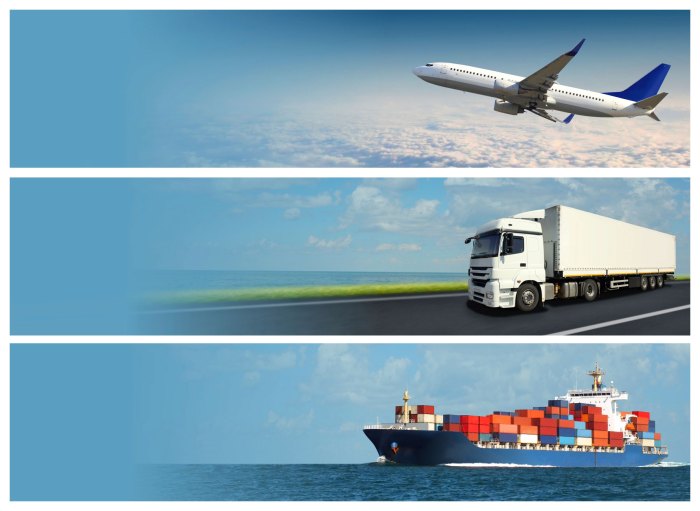
Embark on a journey through the intricate world of logistics for international shipping, where efficiency and precision reign supreme. From textiles to transportation, every aspect plays a crucial role in ensuring seamless global trade.
Let’s dive deeper into the complexities and strategies that drive the success of businesses in the international shipping sector.
Textiles and Nonwovens
Textiles and nonwovens play a crucial role in the international shipping industry, providing essential materials for packaging, protection, and insulation during transportation. These materials are versatile, durable, and lightweight, making them ideal for various logistics applications.
Examples of Textiles and Nonwovens in International Shipping
- Polypropylene woven bags for packaging and transporting goods
- Polyester strapping for securing cargo on pallets
- Nonwoven geotextiles for erosion control in shipping containers
- Fiberglass insulation for temperature-sensitive products
Contribution to Transportation Efficiency
- Textiles and nonwovens help protect goods from damage during transit, reducing the risk of losses for companies and ensuring customer satisfaction.
- These materials are lightweight and flexible, optimizing space utilization in containers and trucks, ultimately leading to cost savings in logistics operations.
- By providing cushioning and insulation, textiles and nonwovens help maintain the quality and integrity of products throughout the shipping process, preventing spoilage or deterioration.
Transportation and Logistics

Transportation plays a crucial role in international shipping logistics, ensuring that goods are moved efficiently and cost-effectively from one location to another. It involves the movement of goods by various modes of transportation to reach their final destination.
Modes of Transportation in International Shipping
- Road Transport: Utilizing trucks and other vehicles for short to medium-distance shipments, road transport offers flexibility and door-to-door delivery options.
- Rail Transport: Cost-effective for long-distance shipments, rail transport is reliable and environmentally friendly, especially for bulk cargo.
- Sea Freight: Ideal for transporting large quantities of goods over long distances, sea freight is economical but slower compared to other modes of transportation.
- Air Freight: The fastest mode of transportation, air freight is suitable for high-value or time-sensitive shipments, although it can be more expensive.
Challenges in Coordinating Transportation and Logistics
- Complex Supply Chains: Managing multiple transportation modes, carriers, and routes can lead to coordination challenges, especially in global shipping operations.
- Customs and Regulations: Navigating different customs procedures and regulations in various countries can cause delays and additional costs in the transportation process.
- Inventory Management: Ensuring sufficient inventory levels at different points in the supply chain while minimizing excess stock requires effective coordination between transportation and logistics.
- Communication and Information Sharing: Lack of real-time communication and information sharing among stakeholders can lead to misunderstandings, delays, and inefficiencies in the transportation process.
Business Creation and Development
Starting a logistics business for international shipping can be a lucrative venture, but it requires careful planning and consideration of various factors. Here are the key steps involved in creating a logistics business for international shipping:
Steps to Create a Logistics Business for International Shipping
- Conduct thorough market research to identify potential demand and competition in the international shipping industry.
- Develop a solid business plan outlining your mission, target market, services offered, pricing strategy, and financial projections.
- Obtain the necessary licenses and permits to operate a logistics business legally, especially for international shipments.
- Build relationships with reliable carriers, suppliers, and partners to ensure smooth and efficient operations.
- Invest in technology and software systems to track shipments, manage inventory, and optimize supply chain processes.
- Create a strong online presence through a website and social media to attract customers and showcase your services.
- Hire experienced staff with knowledge of international shipping regulations, customs procedures, and logistics management.
- Provide excellent customer service to build trust and loyalty with clients for repeat business and referrals.
Key Factors for Developing a Business Strategy in International Shipping Logistics
- Understanding global trade regulations and compliance requirements to ensure seamless cross-border shipments.
- Adapting to changing market trends and customer preferences to stay competitive in the international shipping industry.
- Implementing sustainable practices and green initiatives to reduce environmental impact and meet growing demand for eco-friendly logistics solutions.
- Investing in training and development programs for employees to enhance skills and knowledge in logistics operations and customer service.
- Utilizing data analytics and predictive modeling to optimize routes, reduce costs, and improve overall efficiency in international shipping logistics.
Impact of Technology on Growth and Development of Logistics Businesses in International Shipping
- Automation of processes such as inventory management, order processing, and shipment tracking has increased efficiency and reduced human error in logistics operations.
- Integration of artificial intelligence and machine learning algorithms has enabled real-time decision-making and predictive analytics for better supply chain management.
- Development of blockchain technology has enhanced transparency and security in international transactions, reducing fraud and improving trust among stakeholders.
- Use of Internet of Things (IoT) devices and sensors has enabled tracking of shipments in real-time, leading to improved visibility and control over the entire logistics process.
- E-commerce platforms and digital marketplaces have facilitated direct communication between customers and logistics providers, streamlining the ordering and delivery process for international shipments.
Domestic Services

Domestic services play a crucial role in the success of international shipping logistics by providing essential support and coordination within a country’s borders. Let’s explore the difference between domestic and international logistics services and delve into the significance of domestic services in the context of international shipping operations.
Difference between Domestic and International Logistics Services
Domestic logistics services focus on transportation, warehousing, and distribution activities within a single country, catering to local markets and businesses. On the other hand, international logistics services involve the movement of goods across borders, requiring coordination between multiple countries and compliance with various regulations.
Examples of Essential Domestic Services for Supporting International Shipping Operations
- Transportation Services: Domestic trucking, rail, and air freight services play a vital role in transporting goods to and from ports, airports, and distribution centers, ensuring smooth connectivity for international shipments.
- Warehousing and Storage: Domestic warehouses provide storage facilities for goods awaiting export or distribution, facilitating efficient inventory management and order fulfillment for international shipping.
- Customs Clearance: Domestic customs brokers and agents help navigate import and export regulations, ensuring compliance with customs procedures and documentation requirements for international shipments.
Role of Domestic Services in the Overall Success of International Shipping Logistics
Domestic services act as the backbone of international shipping logistics by providing essential infrastructure, support, and expertise needed to facilitate the movement of goods domestically and to and from international trade routes. They enable seamless connectivity, efficient operations, and timely deliveries, ultimately contributing to the overall efficiency and success of international shipping logistics.
Translation Services
In the realm of international shipping logistics, translation services play a crucial role in ensuring smooth and efficient communication between parties involved in the process. These services are essential for overcoming language barriers and facilitating effective coordination.
Significance of Translation Services
- Translation services help bridge the gap between parties speaking different languages, ensuring that important information is accurately conveyed.
- They enable clear communication between suppliers, manufacturers, carriers, and clients, leading to improved efficiency in the logistics chain.
- By providing accurate translations of shipping documents, labels, and instructions, these services help prevent errors and misunderstandings that could lead to delays or disruptions.
Challenges of Language Barriers and Role of Translation Services
- Language barriers can impede the flow of information in the logistics process, leading to misinterpretations and mistakes.
- Translation services help overcome these challenges by ensuring that all parties involved can understand and respond to communications effectively.
- They play a crucial role in facilitating negotiations, resolving disputes, and building trust among stakeholders from different linguistic backgrounds.
Contribution to Effective Communication and Coordination
- Effective communication is vital in international shipping logistics to ensure timely deliveries and customer satisfaction.
- Translation services contribute to clear and precise communication, reducing the risk of misunderstandings and errors that could impact the delivery process.
- By enabling seamless coordination between international partners, translation services help streamline operations and enhance overall efficiency in the logistics chain.
Closing Summary
As we wrap up our exploration of logistics for international shipping, it’s evident that the fusion of technology, strategic planning, and reliable services is the key to thriving in the global market. Stay tuned for more insights and innovations reshaping the future of international shipping logistics.
FAQs
How do textiles contribute to international shipping logistics?
Textiles provide packaging materials, protective covers, and cushioning products essential for safe transportation of goods.
What are the key challenges in coordinating transportation for international shipping?
Coordinating different modes of transportation, dealing with customs regulations, and managing unforeseen delays are common challenges faced in international shipping logistics.
Why are translation services important in international shipping?
Translation services bridge language barriers, ensuring effective communication between parties involved in the logistics process.





